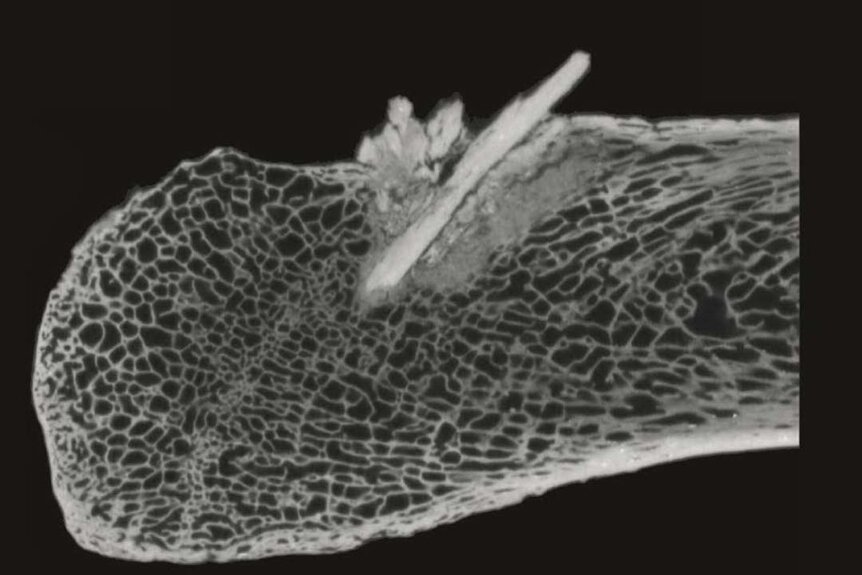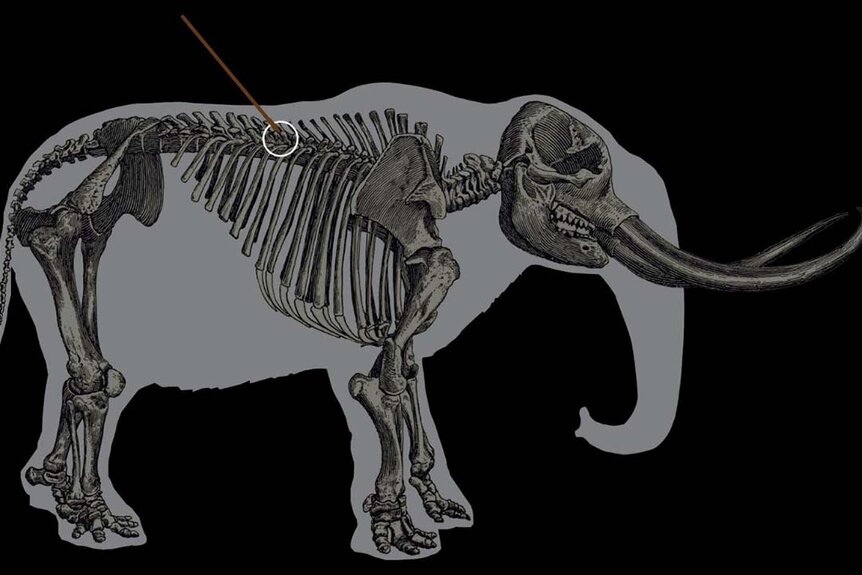Create a free profile to get unlimited access to exclusive videos, sweepstakes, and more!
13,900-year-old spear tip found embedded in mastodon remains
A mastodon bone with a spear tip in it provides the earliest evidence of bone projectiles in North America.

Anatomically modern humans emerged in Africa roughly 300,000 years ago, but we didn’t start recording our activities until just 5,000 years ago. More than 98% of our total history has been lost to time, the only evidence that they happened at all trapped in bones or artifacts left behind. For the most part, we’re left to imagine what life might have been like in the deep past through stories like The Croods: Family Tree (now streaming on Peacock).
The series places viewers in the shoes of a prehistoric family more like us than we might have suspected. They work together to gather enough food, defend their home, and survive, all while looking for a better tomorrow. Certainly, life isn’t easy now, but it was a different kind of difficult back then. Sure, you didn’t have to pay rent, but the only way to get a burger was to chase it down with a spear.
With each new archaeological discovery, we fill in the gaps of our own story a little more, and we’re discovering that things got appreciably easier when groups of humans began developing tools and weapons. Of particular interest, both to ancient humans and the scientists who study them, are projectile weapons which extended hunting range and allowed hunting parties to tackle potentially dangerous game from a moderately safer distance.
RELATED: 'De-extinction company' Colossal Biosciences commits to resurrecting the dodo
Precisely when that started to happen in the Americas has been a matter of some debate, but the recent study of a mastodon bone from a site in Washington state provides the earliest evidence to date of bone projectiles in North America. Michael Waters from the Department of Anthropology at Texas A&M University, and colleagues, studied a 13,900-year-old mastodon rib with a projectile point embedded in it. Their findings were published in the journal Science Advances.
“We’re talking about the tip of a spear. Projectile point is a term archaeologists use for any kind of spear, dart, or arrow shot by an atlatl, a thrown spear, or a shot arrow. Usually, they’re stone but they’ve also been made of bone, ivory, or antler,” Waters told SYFY WIRE.
This particular projectile is believed to have been the business end of a thrown spear. It would have been thrown from a distance with the goal of sliding between the ribs to pierce a vital organ. Unfortunately for the hunter, the throw missed its mark and slammed into one of the mastodon’s ribs. When the end of the projectile made contact with the rib, bits of it sheered or splintered off and embedded into the bone at odd angles. Fortunately, most of the pieces stayed in proximity to their original position, which aided in the reconstruction effort.
“It was a bad shot for the hunter but a good shot for us. They were probably going for the lungs, which extended pretty far back. If you look at the CT images, you’ll see a gray zone where there was a hematoma and some swelling. The bone was trying to heal itself,” Waters said.
Based on what researchers saw in the scans, it appears the animal survived for a number of weeks after the initial attack, before dying. How and why the mastodon died isn’t totally clear. It’s possible that the same hunting party or another party came across it weeks later and finished the job. It’s also possible the initial injuries were bad enough that the animal succumbed or was moving slowly enough that it got taken down by something else. If they threw one spear, they probably threw more. It’s not unlikely this animal was severely injured even after it escaped. In either case, we know that it eventually ended up on the end of a fork. We know that because the bone shows evidence that the animal was butchered by humans after its death.
RELATED: Prehistoric pictographs show ice age sloths and mastodons living with ancient humans
Getting a close look at the embedded spear point presented a challenge because pulling it out risked damaging or destroying the mastodon rib, and they aren’t easy to come by. They could have pulled each shard from the bone and manually stitched it back together like the pieces of a shattered vase, but that might have prevented future scientists from studying the specimen with better technology in the future. Instead, the team relied on CT scans, modeling software, and 3D printers to get at the ancient weapon without actually touching it.
“We took industrial grade CT scans along four different axes of the bone. These individual images are about the thickness of a piece of paper and once we had the slice we had to identify the cortical bone fragment which was foreign to the bone of the rib. Then you get the next slice and do the same thing, and you fill in the gaps with three-dimensional pixels. Slowly but surely, you start building a rendering in three dimensions of what a fragment looked like,” Waters said.
The whole process took roughly 500 hours to complete, but when it was finished researchers had virtual models of each spear point shard, digitally extracted from inside of the bone. When all of the shard renderings were complete, the team took them to a high quality 3D printer and printed out each of the 24 pieces. Then they got to work assembling a 3D jigsaw puzzle to put the pieces back together.
Analyses confirmed that the spear point itself is also made of mastodon bone. As far as we can tell, it came from the thigh bone of another mastodon and was fashioned into a sharpened point for hunting. The presence of the spear point at the Manis site is exciting because it refines our understanding of when people first came to the Americas and the sorts of technologies they either brought with them or developed once they got here.
The Clovis site, one of the most famous early human sites in North America, dates to 13,000 years ago and contains evidence of projectiles made of stone, as well as other tools like blades and scrapers. But Manis shows that at least some groups were using bone tools even earlier.
RELATED: Even cave people longed for the old days: ancient tool recycling driven by stone-age sentimentality
“Now we have the Manis mastodon in Washington which was being hunted with bone weaponry. The other sites don’t have that. And it dates to 13,900 years ago. When you look at the distance between these sites, we’re only talking 250 or 300 miles. Very clearly, when you start looking at this cluster of early sites, it’s really pointing to people traveling along the coast, entering the Americas, venturing inland. Clearly, some of these people must have stayed in the Pacific Northwest and we’re getting a glimpse of their behavior at the Manis site,” Waters said.
There’s a lot we can still learn about the people who lived at the Manis site and the team is hard at work designing additional studies. One of the big open question is how fast these spears could be thrown and, consequently, how deadly they were. Waters has contacted colleagues to help figure that out, and they’ve chosen the most radical method available. Rather than look at the characteristics of the spear point and the rib, quantify the damage, and back into the velocity, they’re going to do something way more metal.
Researchers plan to make several replica spear points identical to the model of the Manis spear point. Then they’ll put them into an air cannon and fire them at model mastodons made of ballistics gel and synthetic bone. By firing the points at different velocities and filming it with a high speed camera, scientists hope to learn more about how these spears behaved in flight and how big of a punch they packed.
Spear points are helpful but the most important tool in any hunter’s toolkit is family. Check out The Croods: Family Tree, streaming now on Peacock!




























